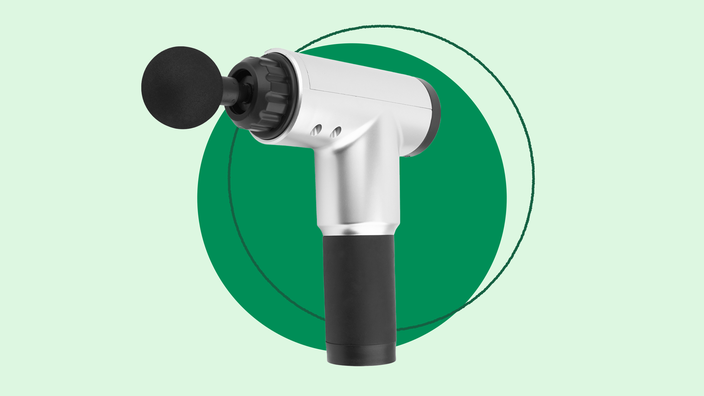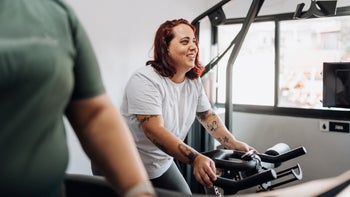
Do Massage Guns Really Work? Benefits, Uses, and More
Key takeaways:
A massage gun provides consistent percussive pressure to targeted muscles.
The handheld device may increase circulation and relieve muscle tension. But not all claimed benefits are backed by science.
Massage guns are generally safe when used correctly. Talk with a healthcare professional to find out if percussive therapy is right for you.
Table of contents

Massage guns are a popular fitness tool among professional athletes and weekend warriors alike. These portable devices offer targeted massage meant to relieve muscle tension. Advocates believe they provide benefits like better athletic performance and faster muscle recovery.
You might be tempted to incorporate a massage gun into your wellness routine. But before you invest, learn more about massage gun benefits and limitations.
How do massage guns work?
A massage gun is a handheld wellness tool that provides percussive massage therapy.
Search and compare options
Percussive therapy uses rapid, repetitive pressure and vibration to massage soft tissue. Each massage gun has a motor that sends steady pulses through the head of the gun. The massage gun head provides precision that lets you target specific areas.
Most massage guns are wireless. Some models allow you to customize your treatment with various speed settings or different attachment heads.
Massage gun benefits
Massage guns are fairly new, and research on their effectiveness is ongoing. Some alleged benefits have yet to be backed by science. But there’s evidence that the tool can offer certain health and fitness advantages.
Here’s what the science says about the benefits of using a massage gun.
1. Boosts circulation
Good circulation is important for your health. You can do several things to improve your circulation, and using a massage gun may be one of them.
Massage guns apply a combination of percussion and vibration. Two small studies found that whole-body vibration therapy can raise blood flow. More studies are needed to see if local vibration from a massage gun can deliver comparable benefits to whole-body vibration therapy.
Read more like this
Explore these related articles, suggested for readers like you.
But experts –– including athletic trainers and physical therapists –– believe massage guns can help boost blood flow, lessen muscle pain, and support postworkout recovery.
2. Eases muscle tension and soreness
The pressure and vibration from a massage gun may help relax tight muscles and ease pain. In a small study, bus drivers with lower back pain received ergonomic advice to make their workspace safe and comfortable. They also completed five weekly percussive therapy sessions using a Theragun. After 3 weeks, they had less back pain and better functional mobility.
3. Reduces delayed-onset muscle soreness
A massage gun might also soothe postworkout aches and pains. Delayed-onset muscle soreness (DOMS) is particularly common among people who try new or more difficult workouts or return to exercise after a break. But it can happen to anyone, even professional athletes.
In a review, researchers looked at 39 studies and found that using a massage gun right after a workout could lessen DOMS.
4. Increases flexibility and range of motion
Increased blood flow and less muscle stiffness after using a massage gun could result in better flexibility and range of motion. A 2023 review found that massage guns can increase flexibility in hip and posterior chain muscles, such as the hamstrings and triceps. They may also improve range of motion after exercise.
5. May enhance athletic performance
Better flexibility and range of motion can boost your workout or sports performance. But research on how massage guns affect athletic performance is limited and mixed.
According to the 2023 review, the wellness tool doesn’t improve strength, balance, or agility. Researchers concluded that massage gun use may even hurt performance in some cases. Another study found that massage guns enhanced range of motion but didn’t strengthen muscles.
But a review of 13 studies found that percussive therapy from massage guns may cause temporary increases in muscle strength and flexibility.
6. Supports muscle recovery
Professional massage therapy can help muscle recovery, and so can a massage gun. The tool has been shown to jumpstart postworkout recovery by boosting blood flow, reducing muscle stiffness, and easing soreness.
Some research suggests that massage guns also help break down lactic acid that builds up in muscle cells during vigorous exercise. That’s important because lactic acid may contribute to muscle fatigue. But the reduction may be minor.
7. Helps manage scar tissue
Research suggests that professional massage therapy may limit pain and thickness in burn scars. Percussive therapy might also help with scar tissue because it uses some of the same mechanics as massage therapy. But there’s a need for more research to support this claim.
What are the risks of using a massage gun?
Massage guns are generally safe. But there are some risks associated with using them. Many risks come from improper or excessive use. For instance, applying a massage gun to a sprain might worsen the injury. And using too much pressure on painful areas may cause pain to flare up even more. Other risks include muscle pain or discomfort and nerve or skin irritation.
In one extreme case, a woman who received percussion therapy developed severe rhabdomyolysis, a serious condition related to damaged skeletal muscle fibers. The study points out that the patient had untreated anemia, which may have been a risk factor.
In another case, a man with glaucoma used a massage gun around his eye. This resulted in a dislocated lens. People with underlying conditions should consult a healthcare professional before using a massage gun.
If you already have a massage gun –– or want one now that you know the possible benefits –– you should consult an expert before using it. Talk with a physical therapist or massage therapist to learn how to use your massage gun safely and effectively.
Then, you can decide how to add your massage gun to your wellness routine. Some people like using the tool to warm up their muscles before a workout. Others grab it after exercise to aid muscle recovery. But you don’t have to wait for your next gym visit to try your massage gun. You can also use it to help soothe muscle soreness or tension.
You can use a massage gun up to 3 times a day. Try spending 10 to 15 seconds on each targeted muscle group per area before moving to another spot.
Rather than holding the massage gun in one spot, keep it moving around the targeted area. Avoid moving it over bones, joints, and injured areas. And never apply a massage gun anywhere on or above your neck.
The amount of pressure you apply with the massage gun is up to you. You should never push so hard that you feel pain. If your skin turns red, it’s time to take a break. Staying in one spot for too long can lead to bruising and tenderness.
How to use a massage gun to relieve or prevent muscle pain
Figure out what muscle area you’d like to target.
Find a comfortable seat and turn on the massage gun.
Move the massage gun head gently across the targeted muscle area, starting with a low-speed setting.
Raise the speed or pressure as needed.
Stop right away and let a healthcare professional know if you feel any pain or discomfort.
What to look for in a massage gun
There are a lot of factors to consider when shopping for a new massage gun, including the following.
Speed and attachments: Look for massage guns with multiple speeds and attachments. That way, you have several options to suit your needs.
Size and portability: A massage gun that’s lightweight and portable makes it easier to target different muscles and take the device on the go.
Noise: Read reviews or test massage guns in-store if you want a quieter model.
Battery life: Try to find a massage gun with a long battery life for added convenience.
Cost and warranty: Massage guns aren’t cheap. They can range from $50 to $400. Choose one with a good warranty that fits your budget.
Frequently asked questions
Massage therapy may be safe during pregnancy. But there’s a need for more research on using massage guns during pregnancy. It’s best to consult a healthcare professional before using a massage gun while pregnant, especially if you have any pregnancy complications or health concerns.
Small studies suggest that massage guns can ease back pain. It may help by increasing blood flow and relaxing tight muscles. But it’s important to use massage guns carefully, especially on sore or sensitive areas, and avoid using them directly on the spine. Talk with a healthcare professional first, especially if your back pain is the result of an injury or condition.
It depends on your fitness goals. Using a massage gun before a workout can boost circulation, warm your muscles, and increase range of motion. After a workout, it can help loosen muscles and relieve muscle soreness. But it might take some trial and error to find out if massage guns are good for you. For example, some research suggests that using a massage gun before exercise can hinder performance.
The bottom line
The research surrounding massage guns is ongoing. There’s enough evidence to support massage gun therapy for muscle pain and recovery. But not all supposed benefits have research to back them up.
For most people, massage guns are safe tools for treating muscle tension. Talk with a healthcare professional before trying one, especially if you are pregnant or have any underlying medical conditions.
Why trust our experts?



References
Abramson, A. (2023). Read this before you buy a massage gun. Consumer Reports.
Alonso-Calvete, A., et al. (2022). Why percussive massage therapy does not improve recovery after a water rescue? A preliminary study with lifeguards. Healthcare.
Cheatham, S. W., et al. (2021). Mechanical percussion devices: A survey of practice patterns among healthcare professionals. International Journal of Sports Physical Therapy.
Chen, J., et al. (2021). Rhabdomyolysis after the use of percussion massage gun: A case report. Physical Therapy & Rehabilitation Journal.
Conrad, A., et al. (2020). The acute effects of a percussive massage treatment with a hypervolt device on plantar flexor muscles’ range of motion and performance. Journal of Sports Science & Medicine.
Deflorin, C., et al. (2020). Physical management of scar tissue: A systematic review and meta-analysis. The Journal of Alternative and Complementary Medicine.
Ferriera, R. M., et al. (2023). The effects of massage guns on performance and recovery: A systematic review. Journal of Functional Morphology and Kinesiology.
Herrero, A. J., et al. (2011). Effects of whole-body vibration on blood flow and neuromuscular activity in spinal cord injury. Spinal Cord.
Johnson, P. K., et al. (2014). Effect of whole body vibration on skin blood flow and nitric oxide production. Journal of Diabetes Science and Technology.
Mansuri, U., et al. (2021). Effectiveness of theragun and ergonomic advice in patients with low back pain among bus drivers - a randomized controlled trial. International Journal of Science and Research.
Martin, J. (2021). A critical evaluation of percussion massage gun devices as a rehabilitation tool focusing on lower limb mobility: A literature review. SportRxiv.
Mu, J., et al. (2022). Lens subluxation after use of a percussion massage gun: A case report. Medicine.
Sams, L., et al. (2023). The effect of percussive therapy on musculoskeletal performance and experiences of pain: A systematic literature review. International Journal of Sports Physical Therapy.
Szymczyk, P., et al. (2022). Acute effects of percussive massage treatment on drop jump performance and achilles tendon stiffness. International Journal of Environmental Research and Public Health.
The American College of Obstetricians and Gynecologists. (2020). Can I get a massage while pregnant?





























